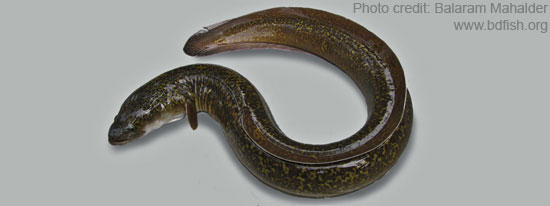
Systematic position
Phylum: Chordata
Class: Actinopterygii (Ray-finned fishes)
Order: Anguilliformes (Eels)
Family: Anguillidae (Freshwater eels)
Genus: Anguilla
Species: A. bengalensis bengalensis
Synonyms
Anguilla arracana McClelland, 1844
Anguilla bengalensis (Gray, 1831)
Anguilla elphinstonei Sykes, 1839
Anguilla nebulosa nebulosa McClelland, 1844
Anguilla variegata McClelland, 1844
Muraena bengalensis Gray, 1831
Common/local names
English: Indian mottled eel and Indian longfin eel
Bangladesh: Banehara, Banehara (বানেহারা), Bamosh (বামোশ), Bao baim (বাও বায়েম), Bao mach (বোয়া মাছ), Boa baim (বোয়া বায়েম) and Telkoma (তেলকোমা)
India: Thumbi (Orissa); Malumgulu and Malugu (Andhra Pradesh); Serampambu, Vellangoo and Porivelangu (Tamil Nadu); Maniangal, Ghalu, Aerel and Vilangu (Kerala); Harimeennu (Karnataka) and Ahir and Aheer (Maharashtra) (Talwar and Jhingran, 1991).
Distributions: Bangladesh (Rahman, 1989 and 2005); India, Pakistan, Sri Lanka, Myanmar and East Indies (Talwar and Jhingran, 1991).
Conservation status: Vulnerable in Bangladesh due to habitat loss and deterioration (IUCN Bangladesh, 2000).
Morphology: Body elongate with conical dorsally flattened head. Vertebrae 106-112 (Talwar and Jhingran, 1991). Anterior nostril tubular, lips thick and well-developed and tail compressed. Scales small and rounded. Distinct and complete lateral line present. No barbels and pelvic fins. 20.5 cm individual fully covered with scales (Shafi and Quddus, 2001).
Body color yellowish to olive-brown, mottled with dark brown. Juveniles are not mottled (Talwar and Jhingran, 1991). Lighter below. Upper surface with darker spots and blotches (Rahman, 1989 and 2005).
Fin formula:
D. 250-305; P. 18; A. 220-250; C. 10-12 (IUCN Bangladesh, 2000)
D 250-305; A 220-250; P 18 (Talwar and Jhingran, 1991)
D. 250-305; P. 18; A. 210-250; C. 10-12 (Shafi and Quddus, 2001)
Maximum length: 118 cm (Rahman, 1989 and 2005); 120 cm (Talwar and Jhingran, 1991) and 120+ cm (Shafi and Quddus, 2001).
Food and feeding: Feeds on small crustaceans, worms, mollusks etc. (IUCN Bangladesh, 2000). According to Shafi and Quddus (2001), it feeds on annelids, crustaceans, macrophytes and microphytes; accidentally takes various organisms too.
Food contents are as follows- fishes (23.55%), shrimp and pawn (22.83%), megalopa larvae (14.86%), crabs (14.50%), macro and microphytes (8.66%), insects (6.88%), annelids (5.07%) and miscellaneous (5.43%) (Shafi and Quddus, 2001).
Habitats: Inhibits hill streams, rivers, ponds and lakes , early life stages in sea (IUCN Bangladesh, 2000). Commonly found in deep rock pools of rivers (Rahman, 2005). Freshwater; also in estuaries and sea during early life and near maturity (Talwar and Jhingran, 1991). Inhibits Kangsha and Someswari hill-streams of Mymensingh, also in Karnafuli reservoir (Rahman, 1989 and 2005).
Found in Karnafuli reservoir and the Bay of Bengal of Bangladesh (IUCN Bangladesh, 2000). Also in Padma, Meghna, Jamuna and Brahmapurta rivers (Shafi and Quddus, 2001).
Spawning and fecundity: Catadromous species; migrates to sea as adult for breeding after 10-15 years in freshwater (IUCN Bangladesh, 2000). Breeds in far offshore areas and possible die; the larvae, which are commonly known as ‘leptocephali’ reach near offshore and after few weeks they metamorphose to tiny-transparent ‘glass eel’ stage and enters rivers (IUCN Bangladesh, 2000). Parents died after breeding (Shafi and Quddus, 2001).
Fecundity is around 100,000 (Shafi and Quddus, 2001).
Fishery info: Has good export markets for both live elvers (eel larvae) and large eels (Talwar and Jhingran, 1991; Rahman, 2005); used as food fish in Maharashtra of India (Talwar and Jhingran, 1991). Highly prized because of its nutritional value (Rahman, 2005). Abundantly caught near Bhairav bridge of Bangladesh (Shafi and Quddus, 2001).
__________________________________________________________
REFERENCES
Gray JE (1831) Illustrations of Indian zoology; chiefly selected from the collection of Major-General Hardwicke, F.R.S., 20 parts in 2 vols. Illustrations of Indian zoology; chiefly selected from the collection of Major-General Hardwicke, F.R.S., Pls. 1-202.
IUCN Bangladesh (2000) Red book of threatened fishes of Bangladesh, IUCN- The world conservation union. xii+116 pp.
McClelland J (1844) Apodal fishes of Bengal. Calcutta Journal of Natural History 5(18):151-226, Pls. 5-14.
Rahman AKA (1989) Freshwater Fishes of Bangladesh, 1st edition, Zoological Society of Bangladesh, Department of Zoology, University of Dhaka, Dhaka-1000, p. 41.
Rahman AKA (2005) Freshwater Fishes of Bangladesh, 2nd edition, Zoological Society of Bangladesh, Department of Zoology, University of Dhaka, Dhaka-1000, pp. 55-56.
Shafi M and Quddus MMA (2001) Bangladesher Matsho Shampad (Fisheries of Bangladesh) (in Bengali), Kabir publication. Dhaka, Bangladesh. pp. 17-20.
Sykes WH (1839) On the fishes of the Deccan. Proceedings of the General Meetings for Scientific Business of the Zoological Society of London 1838 (6): 157-165.
Talwar PK and Jhingran AG (1991) Inland Fishes of India and Adjacent Countries, Vol. 1, Oxford & IBH Publishing Co. Pvt. Ltd. New Delhi-Calcutta, pp. 74-75.
Visited 8,617 times, 1 visits today | Have any fisheries relevant question?
